Introduction
How Long Do Robins Sit On Eggs: Robins, those cheerful and iconic songbirds, are a common sight in many parts of the world, and their presence often heralds the arrival of spring. With their distinctive red breasts and melodious tunes, these feathered creatures have captured the hearts of bird enthusiasts and casual observers alike. Yet, beyond their charming appearances and harmonious songs lies a fascinating aspect of their lives their role as diligent parents. One of the most intriguing behaviors exhibited by robins is their commitment to incubating their eggs, but just how long do robins sit on their eggs. The act of incubation is a crucial phase in a bird’s reproductive cycle, during which the parent bird, typically the female in the case of robins, sits on her clutch of eggs to maintain a stable temperature and humidity level.
This process is vital for the successful development of the embryos within the eggs. For robins, this period of dedication is no less significant, and it offers a glimpse into the remarkable world of avian parenting. To understand how long robins seeds sit on their eggs, we must first delve into the intricacies of their breeding behavior. Robins are known for their distinctive nests, often constructed with a blend of mud, grass, twigs, and lined with softer materials such as feathers or fine grasses. Once the nest is complete, the female robin lays her eggs, typically one per day, until her clutch is complete. The size of the clutch can vary but usually consists of three to five eggs. After the last egg is laid, the female robin begins the incubation process.
This consistent warmth is vital for the development of the embryos, as it accelerates their growth and ensures their survival. The duration of incubation for robins can vary depending on several factors, including environmental conditions and geographic location. On average, however, robin eggs are typically incubated for about 12-14 days. During this time, the female robin rarely leaves the nest, except for brief breaks to feed and hydrate herself. It’s a testament to the bird’s unwavering commitment to her brood, as she diligently tends to her eggs, protecting them from potential threats and ensuring their optimal conditions for growth. In the intricacies of robin incubation, shedding light on the factors that influence its duration, the behaviors exhibited during this period.
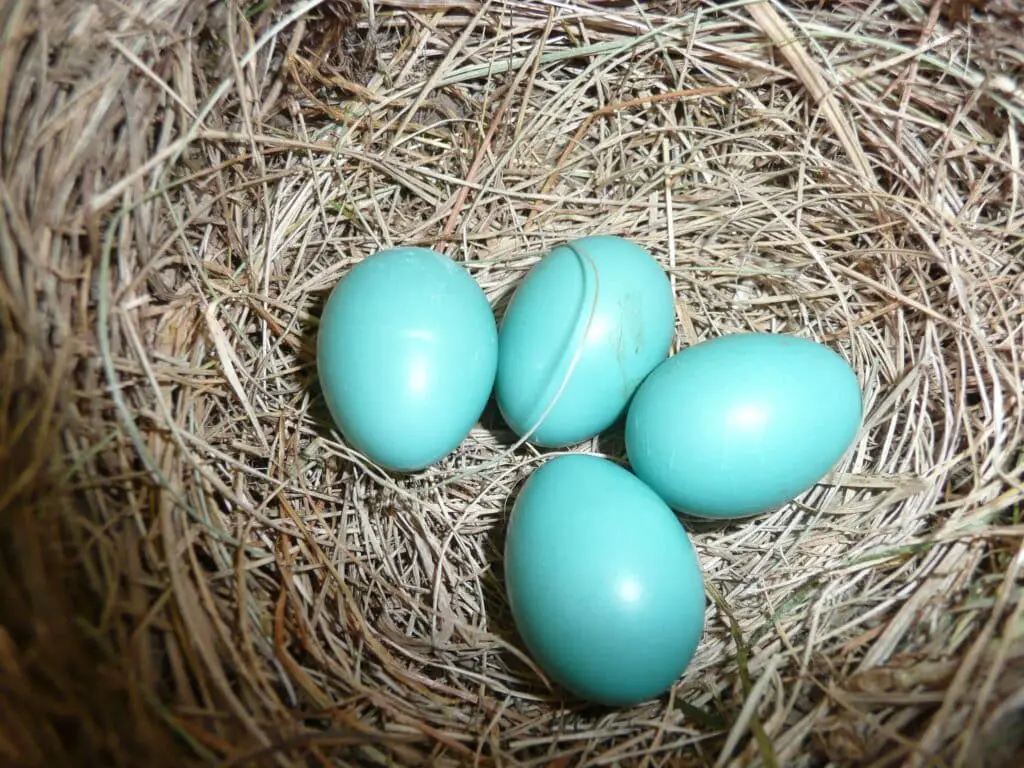
Do robins sit on their eggs all day?
Mother robins may start incubating their eggs during the evening after the second egg is laid, or after all the eggs are laid. They sit on the eggs for 12 to 14 days. The female usually does all the incubating. Even in good weather, she rarely leaves her eggs for more than 5 to 10 minutes at a time.
The robins do spend a substantial portion of their day incubating their eggs. Incubation is a critical phase in the reproductive cycle of birds, and it plays a pivotal role in ensuring the survival of the embryos. When a female robin lays her eggs in a carefully constructed nest, she takes on the primary responsibility of keeping these eggs warm and safe.
Robins typically lay one egg per day until their clutch is complete, which usually consists of three to five eggs. Once the last egg is laid, the incubation process begins. During this period, the female robin sits on the eggs to maintain a stable temperature and humidity level. This consistent warmth is essential for the proper development of the embryos within the eggs.
Robins are diligent parents, and they take their incubation duties seriously. They sit on the eggs to the necessary heat, and they adjust their position regularly to ensure even warmth distribution. This dedication requires them to spend a significant amount of time on the nest. They take short breaks to feed themselves and hydrate. These breaks are essential for their own well-being and help them replenish their energy, ensuring they can continue to care for their eggs effectively.
How long does it take robins to hatch and leave the nest?
Robin eggs
The female typically lays two to four light blue eggs – about the size and weight of a quarter (see photo). The female incubates the eggs over a two-week period and both parents care for the young. The eggs take around two weeks to hatch and the chicks will fledge when they are about 12 to 14 days old.
The first step in the process is incubation. After a female robin has laid her clutch of eggs, which typically consists of three to five eggs, she begins to incubate them. This process involves keeping the eggs warm through the heat of her body. The incubation period typically lasts for about 12-14 days, during which the female robin rarely leaves the nest. Her dedication ensures the eggs receive the consistent warmth they need for proper development.
As the incubation period progresses, the embryos inside the eggs develop, and after about two weeks, they are ready to hatch. The exact timing can vary based on environmental conditions, such as temperature and humidity. The hatching process itself may take a day or so, as the chicks use their egg tooth, a small projection on their beaks, to break out of their shells.
Once the chicks have hatched, they are known as nestlings. During this stage, they are entirely dependent on their parents for warmth, protection, and food. The parents continue to care for and feed the nestlings, providing them with insects and other small prey. This phase typically lasts for about 14-16 days.
How long will a robin sit on unfertilized eggs?
Once the clutch is complete, incubation is by the female alone for 13 days. The shells of the hatched eggs are removed immediately from the nest by the female, who sometimes eats part of them for extra calcium.
Unfertilized eggs are eggs that have not been fertilized by a male robin. In the absence of fertilization, these eggs will not develop into embryos or hatch into chicks. Instead, they remain in the nest as nonviable. The presence of unfertilized eggs can occur for various reasons, such as when a male robin has not successfully mated with the female or when environmental conditions are unfavorable for reproduction.
When a female robin lays eggs, whether they are fertilized or not, she often exhibits incubation behavior. This behavior includes sitting on the eggs to maintain a stable temperature and humidity level. It’s an instinctual response to the presence of eggs in the nest, and it serves to protect the eggs from potential threats and maintain consistent conditions.
The duration of time a robin will sit on unfertilized eggs can vary. Typically, a robin will incubate her eggs for about 12-14 days if they are fertilized and viable. However, when the eggs are unfertilized, the robin may continue to exhibit incubation behavior for a similar duration or even longer.
Will a robin sit on an empty nest?
It’s not unusual for this to happen a day or so before females begin to lay eggs, but it is more unusual for a female to occupy and defend an empty nest for days or weeks at a time.
Robins, like many bird species, have a strong nesting instinct. Once they’ve built a nest and laid their eggs, it’s common for the female robin to spend a significant amount of time on the nest, exhibiting incubation behavior. This behavior involves sitting on the eggs to warmth and protection.
The duration of time a robin will sit on an empty nest can vary. It’s not uncommon for this behavior to persist for a few days or even longer. However, as the days pass, the robin is likely to gradually reduce the time spent on the nest and eventually abandon it as she realizes there are no eggs or chicks to care for.
Environmental factors, such as changes in weather, food availability, or disturbances near the nest, can influence a robin’s behavior. If conditions become unfavorable or if there is a disruption, the robin may abandon the empty nest more quickly.
How many baby robins survive?
An American Robin can produce three successful broods in one year. On average, though, only 40 percent of nests successfully produce young. Only 25 percent of those fledged young survive to November. From that point on, about half of the robins alive in any year will make it to the next.
The survival of baby robins starts with successful nesting. Female robins carefully select nesting sites and construct nests to protect their eggs and chicks. Nests located in secure and concealed locations, away from predators and adverse weather, have a higher chance of success.
The viability of robin eggs plays a crucial role in the survival of the chicks. If the eggs are fertilized and healthy, the chances of successful hatching are higher. However, some eggs may not hatch due to various reasons, such as infertility or damage.
The incubation period is a critical phase for the survival of robin chicks. The female robin incubates the eggs to keep them warm and safe. During this time, her dedication ensures the eggs develop properly. Temperature fluctuations or prolonged periods away from the nest can negatively impact egg survival.
Predators pose a significant threat to robin nests and their occupants. Common nest predators include snakes, raccoons, squirrels, and birds like crows or jays. Parents are often vigilant and protective, but predation can still occur.
How long does it take for a baby robin to fly?
How long does it take a fledgling robin to learn to fly? Fledglings leave the nest in about 13 days, but most won’t be able to fly right away. It will take them another week or two to master this skill; in the meantime, you can often observe them hopping on the ground.
Once hatched, the baby robin enters the nestling stage. At this point, it is entirely dependent on its parents for warmth, protection, and food. The nestling stage typically lasts for about 14-16 days. During this period, the chicks grow rapidly, and their primary job is to eat and grow.
Parent robins are highly dedicated to providing for their nestlings. They tirelessly forage for insects and other small prey, returning to the nest to feed their hungry chicks. This continuous provisioning ensures the chicks receive the nutrition they need for proper growth.
As the nestlings grow, their wing feathers gradually develop. At first, the wings are small and weak, but with each passing day, they become stronger and more functional. Wing development is a crucial step toward achieving flight.
Baby robins often engage in wing exercises inside the nest. They flap their wings vigorously, strengthening the wing muscles and practicing the movements required for flight. These exercises are essential for building the necessary strength and coordination.
How often do baby robins eat?
In nature, the parent robins are constantly searching for food and feeding their babies during daylight hours. A baby robin should be fed as much as it can eat at least every half hour from sunrise to sunset. You can take a 2-3 hour break maybe once a day.
The feeding frequency of baby robins varies depending on their age. When they are very young, just after hatching, they require frequent feedings throughout the day. As they grow, the intervals between feedings may become slightly longer.
During the first few days of their lives, baby robins are extremely vulnerable and rely on their parents for almost constant feeding. Parent robins work tirelessly to collect insects and other small prey to their chicks with the essential nutrients they need to grow.
Each feeding session typically lasts only a few minutes, as the parent delivers a small amount of food to each chick. The parent may feed the chicks multiple times in a row, ensuring that each one gets its share. Baby robins are active feeders, and their parents meals throughout the daylight hours. This means that the chicks receive frequent feedings from morning to evening.
How many times will a robin use the same nest?
How many times does a robin build a nest in one breeding season? A. Robins goes through the nest-building process each time they produce a new brood, so about two or three times a season. While robins might repair or build on top of a previous nest, most of them build a new nest for each “family” they raise.
Typically, robins prefer to build fresh nests for each breeding attempt. This behavior is driven by their instinct to the best possible nesting environment for their offspring. Building a new nest allows them to inspect and repair any damage that may have occurred to the previous nest, ensuring it’s in optimal condition.
The location of a nest can influence whether a robin chooses to reuse it. If a nest is in a favorable and secure location, such as a well-protected spot, it may be more likely to be reused for subsequent broods. However, if the location becomes compromised or exposed, the robin is more likely to build a new nest.
Sometimes, a robin’s nest may become damaged or infested with parasites during the breeding season. In such cases, robins are more inclined to build a new nest for their next brood to avoid the challenges associated with a compromised nest. Environmental factors, such as severe weather events, can impact the decision to reuse a nest.
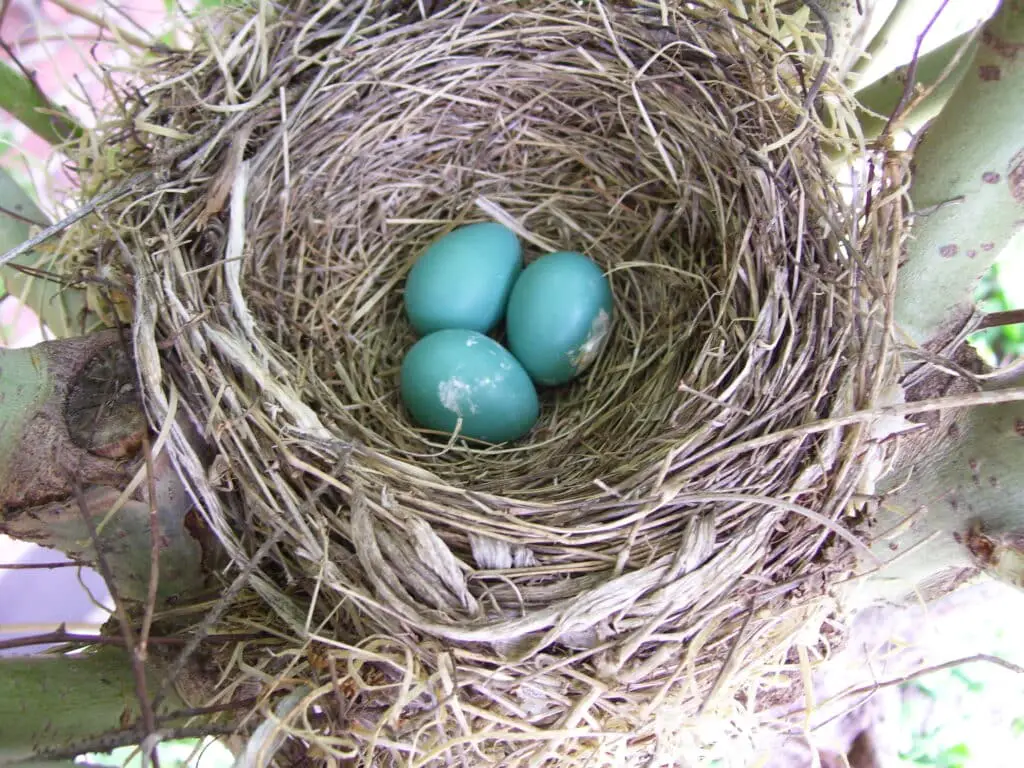
Conclusion
The duration of time that robins spend sitting on their eggs is a testament to the remarkable commitment and dedication of these feathered parents. Throughout this we’ve delved into the fascinating world of robin incubation, exploring the factors that influence the length of this crucial period and the behaviors exhibited by these birds during this time. Robin nesting, with their striking red breasts and melodious songs, captivate our attention when they arrive each spring. However, it is their role as parents that truly showcases the wonders of nature. When a female robin lays her eggs in a meticulously constructed nest, she embarks on a journey of nurturing and protection that can last for approximately 12-14 days.
During this period, she forsakes many of her own needs, dedicating herself entirely to the well-being of her developing embryos. The commitment displayed by robin parents goes beyond mere warmth provision. They guard their nests diligently, warding off potential threats, such as predators or intruders, with fierce determination. Their vigilant watch ensures that their eggs remain safe and undisturbed. While the average incubation period is a general it’s that environmental conditions, geographical location, and individual variations can all influence the exact duration. Robins adapt to the circumstances presented by their surroundings, showcasing their resilience and adaptability as a species.
The ultimate reward for this unwavering dedication is the hatching of their precious offspring. Witnessing the emergence of tiny, vulnerable chicks from their eggs is a moment of triumph for these devoted parents. From that point forward, the responsibilities of robin parenting continue, as they tirelessly feed and protect their young until they are ready to fledge and explore the world on their own. In the grand tapestry of the natural world, the commitment of robins to their eggs stands as a remarkable example of parental devotion. Their willingness to sacrifice their comfort and security for the sake of the next generation is a testament to the wonders of the avian world.

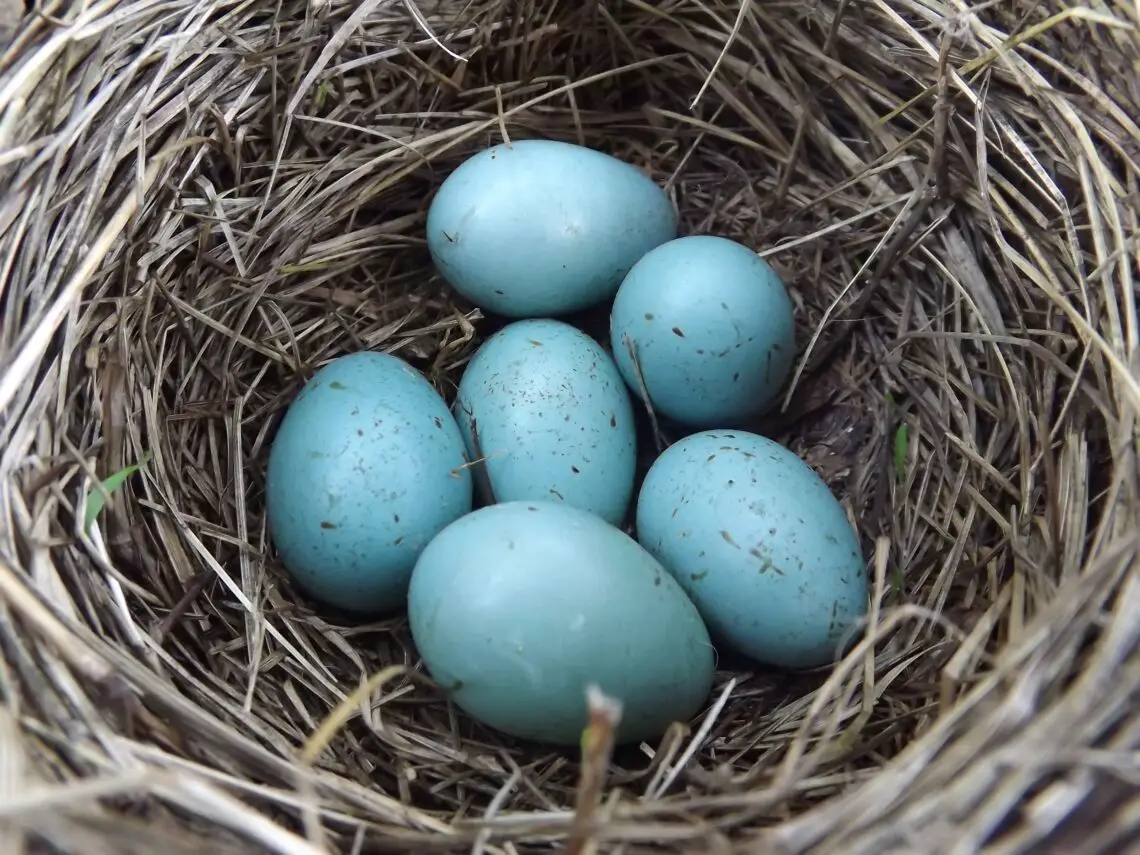
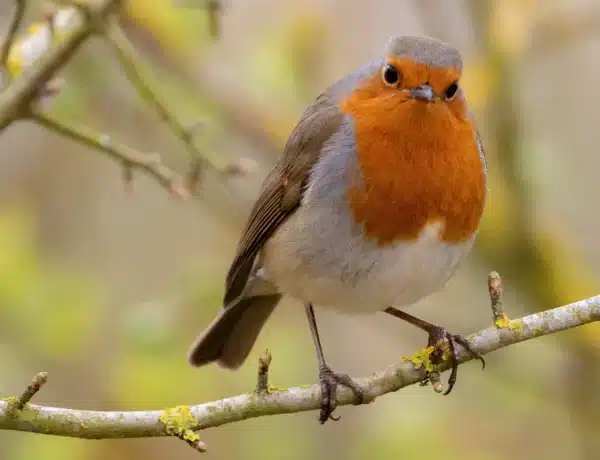
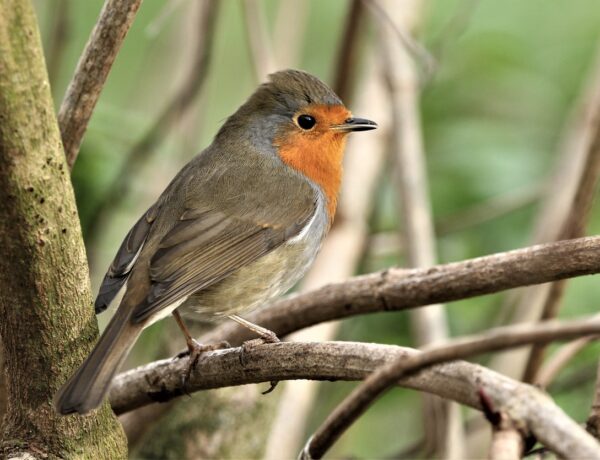

No Comments